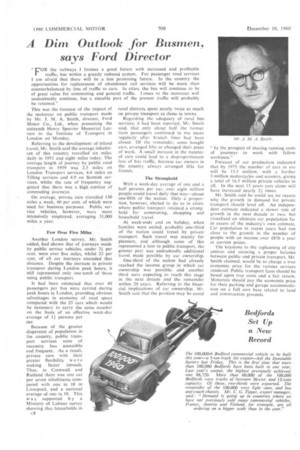A Dim Outlook for Busmen, says Ford Director
Page 44

If you've noticed an error in this article please click here to report it so we can fix it.
" FOR the railways I foresee a good future with increased and profitable traffic, but within a greatly reduced system. For passenger road services am afraid that there will be a less promising future. In the country the . opportunities for replacement of abandoned rail services will be more than counterbalanced by loss of traffic to cars. In cities, the bus will continue to be of great value for commuting and genera! traffic. Losses to the motorcar will undoubtedly continue, but a sizeable part of the present traffic will probably be retained."
This was the forecast of the impact of the motorcar on public transport made by Mr. J. M. A. Smith, director, Ford Motor Co., Ltd., when presenting the sixteenth Henry Spurrier Memorial Lecture to the Institute of Transport in London on Monday.
Referring to the development of inland travel, Mr. Smith said the average inhabitant of this country travelled six miles daily in 1951 and eight miles today. The average length of journey by public road transport in 1959 was 2.3 miles on London Transport services, 4.4 miles on Tilling services and 4.9 on Scottish services, whilst the rate of frequency suggested that there was a high content of commuting journeys.
On average, private cars travelled 150 miles a week, 40 per cent, of which were used for business purposes. Public service vehicles, however, were more intensively employed, averaging 3L000 miles a year.
Few Over Five Miles • Another London survey, Mr. Smith added, had shown that of journeys made by public service vehicles, under .31 per cent, were over five miles, whilst 23 per cent, of all car journeys exceeded that distance. Despite the increase in private transport during London peak hours, it still represented only one-tenth of those using public transport.
it had been estimated that over 40 passengers per bus Were carried during peak hours in London., providing obvious advantages in economy of road space compared with the 25 cars which would be necessary to carry the same number on the basis of an effective week-day average of l persons per car.
Because of the greater dispersion of population in the country, public transport services were of necessity less accessible and frequent. As a result, private cars with their greater flexibility were making faster inroads. Thus, in Cornwall and Rutland there was one car per seven inhabitants compared with one in 18 in Liverpool, and a national average of one in 10. This w a s supported b y a Ministry of Labour survey showing that households in
rural districts spent nearly twice as much on private transport as those in towns.
Regarding the adequacy of rural bus services, it had been reported. Mr. Smith said, that only about half the former train passengers continued to use nuscs regularly after branch lines had been closed. Of the remainder, some bought cars, arranged lifts or changed their place of work. A small increase in the number of cars could lead to a disproportionate loss of bus traffic, because car owners in the country always arranged lifts for friends.
The Stronghold With a week-day average of one and a half persons per car, over eight million people could travel daily that way—about one-fifth of the nation. Only a proportion, however, elected to do so in cities, where public transport retained a stronghold for commuting, shopping and household travel.
At week-ends and on holiday, when families were united, probably one-third of the nation could travel by private .transport. Such •travel was mainly for pleasure, and although some of this represented a loss to public transport, the greater part was undoubtedly additional travel made possible by car ownership.
One-third of the nation had already reached the income group in which car ownership was possible, and another third were expecting to reach this stage in the next decade and the remainder within 20 years. Referring to the financial implications of car ownership, Mr. Smith said that the position may be cased " by the prospect of sharing running costs of journeys to work with fellow workmen."
Forecast of car production indicated that by 1975 the number of cars in use will be 13.5 million, with a further 3 million motorcycles and scooters, giving a total of 16.5 million private vehicles in all, in the next 15 years cars alone will have increased nearly 21 times.
Mr. Smith said he could see no reason why the growth in demand for private transport should level off. An independent estimate indicated a slower rate of growth in the next decade or two, but visualized an ultimate car population fat in excess of the industry's own estimate. Car population in recent years had run close to the growth in the number of people with an income over £850 a year at current prices.
The keystone to the replanning of city centres and securing a proper balance between public and private transport. Mr. Smith claimed, would be to charge a true economic price for the various services rendered. Public transport fares should be based upon true costs and a fair return. Motorists should pay the economic price for their parking and garage accommodation on a full cost base related to land and construction grounds.
























































































































